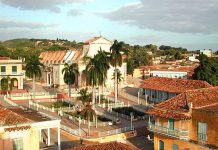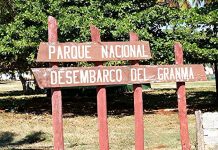
Contents
- 1 Pico La Bayamesa National Park a feast for the eyes
- 2 How to get to Pico La Bayamesa National Park?
- 3 Reasons to visit Pico La Bayamesa National Park
- 4 What is Pico La Bayamesa National Park like?
- 5 Flora and fauna in Pico La Bayamesa National Park
- 6 Pico La Bayamesa
- 7 Places that you cannot miss during your stay in Pico La Bayamesa National Park
- 8 Paragliding and paramotoring
Pico La Bayamesa National Park a feast for the eyes
The Pico la Bayamesa National Park covers an area of 24,210 hectares.
It is a beautiful place where the hillsides melt with the intense green of the vegetation, a gift to the eyes. It was declared a National Park in 2001.
It is located in mountainous areas with difficult access between two Cuban provinces: between Granma in the Guisa and Buey Arriba municipalities and in the Santiago de Cuba province, in the Guamá municipality.
Because it is an area dedicated to recreation and the protection of ecosystems, it has been classified within Category II according to the criteria of the International Union for the Conservation of Nature (IUCN, 1994), which includes National Parks.
It also holds international recognition, it was declared an Important Bird Conservation Area (IBA).
How to get to Pico La Bayamesa National Park?
There are 3 ways to get to the park. The first is from Guisa, along the roads that lead to the María Tomasa and Pino del Agua Abajo settlements.
The second from Buey Arriba, in the community of San Pablo de Yao, along the road that goes to Pata la Mesa and Barrio Nuevo.
The third is through the town of Los Gallegos, from the Peladeros bridge, in the municipality of Guamá, where it is reached from Santiago de Cuba by the Granma highway.
Reasons to visit Pico La Bayamesa National Park
In addition to constituting one of the best preserved wooded areas on the island and hosting multiple animal and plant species, it is also a historical territory.
Many of the battles were fought there in the last months of 1958, although in addition, the hill was witness to a hundred years before the desire of the Mambises to see the homeland free.
The La Mesa Command stands out among the most important historical places, in which Che Guevara developed his capacity as a military strategist.
On this site, in the midst of the war, the guerrilla created a hospital, a bakery-candy store, a store, a prison, a carpentry, a radio station, a cocktail bar, an armory, and the El Cubano Libre printing press.
He also installed a power plant to bring power to the hospital.
It is, without a doubt, the Pico La Bayamesa National Park, a place that you cannot miss to learn both the history of Cuba and its natural beauties.
If you are a lover of modalities such as hiking, this is your opportunity to take care of the environment, to fuse ties with the local culture.
What is Pico La Bayamesa National Park like?
Geography
The Pico La Bayamesa National Park dates back millions of years and the Pico La Bayamesa, with the same name, is the highest elevation in the park, at 1,756 meters above sea level.
Its geological age dates from the Lower Eocene to the upper part of the Upper Eocene and Upper Cretaceous.
Andesite and tuff rocks abound there, and also small layers of clastolavas and andesite strata, basalts and rare limestone appear.
Climate
Due to its rich hydrographic network and dense vegetation, this area has an enviable climate.
Numerous precipitations, dense fog in the crowns of the highest peaks and average temperatures make this a rather humid place.
There is a rich hydrographic network in the park formed by numerous rivers and streams, the influence of horizontal precipitation is remarkable, mainly at the level of 800 and 1,200 meters above sea level, where the formation of low clouds is found.
Flora and fauna in Pico La Bayamesa National Park
Flora
It is important to say that the Pico La Bayamesa National Park keeps within itself the best preserved wooded areas of the Sierra Maestra and in general of the entire country.
509 species from 115 families have been counted, with 25% endemism. The vegetation formations that can be observed the most are the mountain rain forests, cloudy mountains and pine forests.
One of the species that is in extinction is the cashew, both the high sierra and the low sierra.
The high mountain cashew or Magnolia cubensis shows a very poor population with 150 to 200 mature individuals and at the same time poor natural regeneration.
On the other hand, there is the low mountain cashew or M. minor. Of this only 40 adult specimens are counted.
Other endemic plant varieties from the east of the Greater Antilles that show the same situation are the sabicú de la maestra or Abarema maestrensis with only 60 and 70 adults, as well as the Illicium cubense, Tabebuia shaferi and Begonia cubensis.
Fauna
Regarding the fauna, there are 87 families and 242 species. Of these, 84 are endemic and 17 local endemic.
There are 23 species of butterflies originating from various places and some that only belong to the hills of the eastern region, such as the Cuban Anetia and the A. briarea numidia, which are in danger of extinction.
Other important species such as the Cuban Greta or crystal butterfly and the Gundlach butterfly or Parides gundlachianus should also be mentioned.
In addition, 13 species of terrestrial mollusks were registered, belonging to 8 families and 11 genera, and as regards birds, there are 76 species, 11 of them endemic.
3 of these species only live in park areas.
16 species of amphibians and 20 of reptiles, of which 15 amphibians and 17 reptiles are endemic to Cuba at a specific level, and, of these in turn, 7 amphibians and 4 reptiles are endemic to the Sierra Maestra itself.
Pico La Bayamesa
The national park bears its name derived from Pico Bayamesa, the highest elevation in the park, at 1,730 meters above sea level.
In 2008 a group of people, hikers in this case, placed a bust with the image of Carlos Manuel de Céspedes.
He also has the phrase with which he addressed his slaves at the La Demajagua sugar mill, on October 10, 1868, the date that marks the beginning of the independence feats in Cuba: ¨Those who want to follow me, let them follow me ¨, work by the sculptor Odarés Pujol Velázquez.
Places that you cannot miss during your stay in Pico La Bayamesa National Park
Guisa, one of the access points to the Pico La Bayamesa National Park, has in its geography diverse places and beautiful landscapes.
During your visit to this site in the eastern mountains, you can access whatever you decide, always with the commitment to protect the environment, the conservation of native flora and fauna and direct contact with the history of the territory.
You can also access activities such as paragliding and paramotoring.
Cupaynicú Botanical Garden
Institution dedicated to the Conservation of the native Flora of the Granma province and the country, as well as the Protection of the Environment. It is the third most important botanical garden in the country.
You take its name from the river that runs through it: the Cupaynicú. It has 104 hectares and there are more than 1,800 species of plants and trees that are more than one hundred years old.
Its areas are ideal for healthy recreation and education.
Charco Prieto
Charco Prieto is located in the Vega Grande community, 8 km from Guisa.
It limits to the east with El Sordo, to the south with Los Corrales, to the west with Los llanos and to the north with Barrabá. There you can only get there on horseback or by 4X4 jeep. Ideal to get closer to nature and the beauties of the mountains.
The main tourist activity that is promoted is hiking to appreciate the beauty of the mountainous landscape and also a bath in the Guisa river.
Media Luna peasant farm
The Media Luna farm is located almost four kilometers from Guisa.
In it you can make excursions through the fruit farm, observe the poultry, the pig and goat, as well as the banana plantations, fruit, vegetables, tropical meats.
There is an orchid garden. You can also see first-hand how roasted coffee is piled up and taste it, in addition to the offer of Creole food and entertainment games.
Hiking activities are promoted, exchanges on topics related to agroecological agriculture, sale of products made from the fruits that are ecologically harvested on the farm itself.
Paragliding and paramotoring
For lovers of the Heights there is the option of paragliding. It is the lightest flying machine that exists and therefore it is one of the most popular.
A very light, semi-rigid, airship glider is used that is easy to handle.
The paramotor is a variation of the paraglider. The wind speed is generated by the propulsion provided by a small motor with a propeller that is located on the back of the pilot that, when exceeding the necessary speed, takes off.







